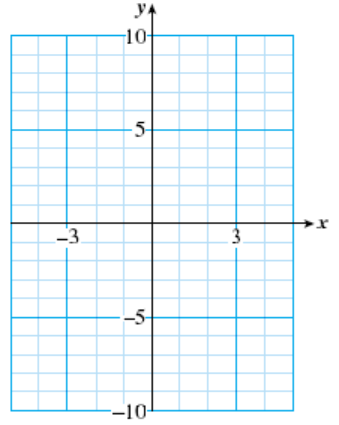Quadratic Equations.
A quadratic equation can be written in the standard form
\begin{equation*}
ax^2+bx+c=0
\end{equation*}
where \(a,~b,\) and \(c\) are constants, and \(a\) is not zero.
| \(~x~\) | \(-3\) | \(-2\) | \(-1\) | \(0\) | \(1\) | \(2\) | \(3\) |
| \(~y~\) | \(9\) | \(4\) | \(1\) | \(0\) | \(1\) | \(4\) | \(9\) |

| \(~x~\) | \(-3\) | \(-2\) | \(-1\) | \(0\) | \(1\) | \(2\) | \(3\) |
| \(~y~\) | \(5\) | \(0\) | \(-3\) | \(-4\) | \(-3\) | \(0\) | \(5\) |
| \(~x~\) | \(-3\) | \(-2\) | \(-1\) | \(0\) | \(1\) | \(2\) | \(3\) |
| \(~y~\) | \(13\) | \(3\) | \(-3\) | \(-5\) | \(-3\) | \(3\) | \(13\) |

| \(~x~\) | \(~y~\) |
| \(0\) | \(\hphantom{0000}\) |
| \(1\) | \(\hphantom{0000}\) |
| \(2\) | \(\hphantom{0000}\) |
| \(3\) | \(\hphantom{0000}\) |
| \(-1\) | \(\hphantom{0000}\) |
| \(-2\) | \(\hphantom{0000}\) |
| \(-3\) | \(\hphantom{0000}\) |
| \(~x~\) | \(~y~\) |
| \(0\) | \(\hphantom{0000}\) |
| \(1\) | \(\hphantom{0000}\) |
| \(2\) | \(\hphantom{0000}\) |
| \(3\) | \(\hphantom{0000}\) |
| \(-1\) | \(\hphantom{0000}\) |
| \(-2\) | \(\hphantom{0000}\) |
| \(-3\) | \(\hphantom{0000}\) |
| \(~x~\) | \(-3\) | \(-2\) | \(-1\) | \(0\) | \(1\) | \(2\) | \(3\) |
| \(~y~\) | \(\hphantom{00}\) | \(\hphantom{00}\) | \(\hphantom{00}\) | \(\hphantom{00}\) | \(\hphantom{00}\) | \(\hphantom{00}\) | \(\hphantom{00}\) |
| \(~x~\) | \(-3\) | \(-2\) | \(-1\) | \(0\) | \(1\) | \(2\) | \(3\) |
| \(~y~\) | \(\hphantom{00}\) | \(\hphantom{00}\) | \(\hphantom{00}\) | \(\hphantom{00}\) | \(\hphantom{00}\) | \(\hphantom{00}\) | \(\hphantom{00}\) |
| \(~x~\) | \(-3\) | \(-2\) | \(-1\) | \(0\) | \(1\) | \(2\) | \(3\) |
| \(~y~\) | \(\hphantom{00}\) | \(\hphantom{00}\) | \(\hphantom{00}\) | \(\hphantom{00}\) | \(\hphantom{00}\) | \(\hphantom{00}\) | \(\hphantom{00}\) |

| \(~x~\) | \(-4\) | \(-2\) | \(-1\) | \(0\) | \(1\) | \(2\) | \(4\) |
| \(~y~\) | \(\hphantom{00}\) | \(\hphantom{00}\) | \(\hphantom{00}\) | \(\hphantom{00}\) | \(\hphantom{00}\) | \(\hphantom{00}\) | \(\hphantom{00}\) |




| \(~r~\) | \(~C~\) |
| \(0\) | \(\hphantom{0000}\) |
| \(1\) | \(\hphantom{0000}\) |
| \(2\) | \(\hphantom{0000}\) |
| \(4\) | \(\hphantom{0000}\) |
| \(6\) | \(\hphantom{0000}\) |
| \(9\) | \(\hphantom{0000}\) |
| \(10\) | \(\hphantom{0000}\) |
| \(14\) | \(\hphantom{0000}\) |
| Velocity (kph) | Distance (meters) |
| \(5\) | \(\hphantom{0000}\) |
| \(10\) | \(\hphantom{0000}\) |
| \(15\) | \(\hphantom{0000}\) |
| \(20\) | \(\hphantom{0000}\) |
| \(40\) | \(\hphantom{0000}\) |
| \(60\) | \(\hphantom{0000}\) |



| \(~t~\) | \(~h~\) |
| \(0\) | \(\hphantom{0000}\) |
| \(0.5\) | \(\hphantom{0000}\) |
| \(1\) | \(\hphantom{0000}\) |
| \(1.25\) | \(\hphantom{0000}\) |
| \(1.5\) | \(\hphantom{0000}\) |
| \(1.75\) | \(\hphantom{0000}\) |
| \(2\) | \(\hphantom{0000}\) |
| \(2.25\) | \(\hphantom{0000}\) |
| \(2.5\) | \(\hphantom{0000}\) |